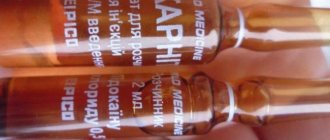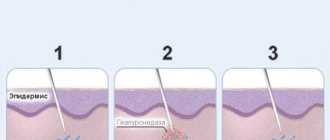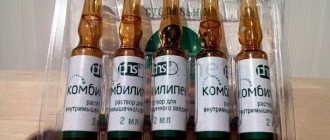No. 1. Why are intra-articular injections better than intramuscular ones? Or do they give the same result?
Intra-articular injections are more effective than intramuscular injections because the medicine is delivered directly into the affected joint. A variety of medications are sent into the cavity, which relieve pain and inflammation, restore cartilage tissue, and become synovial fluid prostheses. The main thing is that they act in a targeted manner. Intramuscular injections are less effective, since the active substance is distributed throughout the body through the bloodstream and enters the joint in a much lower concentration.
Intra-articular injections hit the target exactly – they act on the affected joint
Advantages and disadvantages
The advantages of intra-articular injections include a fairly rapid therapeutic effect. The medicine immediately enters the affected joint and begins to act. The benefits of treatment should also be noted. Very often, a course of injections in combination with other methods allows you to avoid surgery. For example, the price of injections for arthrosis will be significantly lower than the cost of prosthetic surgery.
Disadvantages include individual intolerance to the drug, allergic reactions and possible inflammation of soft tissues after injection.
If you experience joint pain, do not tighten it under any circumstances. Contact an experienced specialist immediately. In a medical clinic, after an examination, the doctor will develop an individual treatment that will help you return to your normal lifestyle without restrictions and pain.
You can find out prices for injections for joints, as well as make an appointment directly on our website.
#2: Are there studies that support the effectiveness of this method?
Despite the fact that the method has not been used for the first year, its research is regularly carried out all over the world, namely testing old and new drugs. Particular attention is paid to drugs based on hyaluronic acid and its synthetic substitutes, since the method of restoring synovial fluid in the joint is considered one of the most effective in the treatment of osteoarthritis.
From year to year, the drugs confirm their high effectiveness compared to tablets that relieve pain and inflammation. Synthetic analogues, for example Noltrex, which does not cause allergies or adverse reactions, are considered safer and more effective.
Indications and contraindications
Injections to restore joints and cartilage are used for inflammatory and degenerative joint diseases, strictly as prescribed by a doctor:
| Indications | Contraindications |
|
|
The main purposes of intra-articular administration of drugs:
- Relieve pain
. Injections for joint pain can achieve a quick pain-relieving effect, for example, drug blockades for joint syndrome. This treatment has a long-term effect, sometimes up to several months; if necessary, blockades can be repeated many times.
- Relieve inflammation
. The drugs used help eliminate the inflammatory process inside the joint and relieve swelling. Steroidal anti-inflammatory drugs (diprospan, hydrocortisone, dexamethasone) are most often prescribed.
- Joint restoration
. Prescribed to stimulate the regeneration of damaged tissues, nutrition and strengthening of articular cartilage, for example, plasma lifting, PRP therapy.
The number of injections depends on the stage of the disease and the drug administered. For example, for arthrosis of the knee joint, the number of intra-articular injections can be from 1 to 5.
No. 4. What needles are used for intra-articular injections?
The choice of needle depends on the location of the affected joint. For arthrosis of the hand or other small joints, doctors select thin and short needles, similar to an insulin syringe. Injections into the shoulder or knee joint require a longer needle that will reach into the cavity. For the hip, it should be even larger, and if the patient is overweight, the instrument is selected individually.
For intra-articular injections into different joints, needles of various thicknesses and lengths are used.
No. 7. How to give an injection into a joint?
There are several methods. There are two access points for the shoulder joint. The injection into the knee is done in one way, and if there is a need to pump out fluid, the doctor can choose one of three available points. To accurately get into the joint cavity, ultrasound is often used. This is especially important in the treatment of arthrosis of the hip joint, which has a complex configuration in itself and has difficult access.
After the injection, the patient is asked to make several movements so that the drug is evenly distributed over the cartilage surfaces. Then apply a tight bandage or cover the injection site with a sterile napkin.
There is no recovery or rehabilitation period after intra-articular injections
Intra-articular injections are practiced for various diseases:
- arthrosis;
- arthritis;
- gout;
- carpal tunnel syndrome;
- adhesive capsulitis;
- bursitis;
- synovitis;
- tendinitis, etc.
They are prescribed for acute pain in the joint, for damage to ligaments, tendons and articular cartilage. In many cases, this method becomes an addition to the complex treatment of osteoarthritis or other diseases. Injections can reduce the amount of painkillers, which is especially important in case of undesirable consequences for the gastrointestinal tract. Different drugs are administered intra-articularly - depending on this, different results are expected.
No. 10. What drugs are injected into the joint and for what purpose?
There are several types of drugs that are injected into the joint for different therapeutic purposes. Anesthetics quickly and briefly relieve pain, so they are used in combination with other medications. Glucocorticoids relieve inflammation for a period of a week to a month. They can be injected into the joint no more often than 3-5 times a year.
Chondroprotectors restore cartilage tissue, and synovial fluid prostheses based on hyaluronic acid or its synthetic substitutes expand the friction surfaces. The patient's blood plasma, enriched with platelets, has a complex effect, but plasma therapy for arthrosis is not used very often due to the high cost of the method.
More and more practicing orthopedists and rheumatologists recommend this method to their patients. If injections of anesthetics are short-term, then intra-articular injections of synovial fluid prostheses provide long-term relief and relieve pain for a year and a half. The most effective drugs are those with high molecular weight, among which Noltrex occupies a leading position.
Injections for joints - review of drugs and technique
Review of drugs for injection into joints for pain, inflammation and limited mobility. Description of chondroprotectors, corticosteroids, drugs with hyaluronic acid. Features of the method and execution technique.
Joint injections are an important part of the treatment of various rheumatic diseases and one of the stages of recovery from injuries. They can be prescribed both in the initial stages and in advanced cases. The advantage of this method is that it allows you to deliver the medicine directly to its destination.
Review of drugs for injection into the joint
They should only be performed by a doctor who has experience in injecting drugs into joints. This does not require hospitalization; the patient can go home immediately after the injection. One session takes no more than 5-10 minutes with all stages. A prerequisite is to treat the injection sites with alcohol for disinfection purposes.
Overview of corticosteroids for joint injections
These drugs are made on the basis of glucocorticoid hormones, which have a powerful anti-inflammatory effect. Introducing them into the joint cavity can reduce swelling, suppress pain and eliminate redness. Such injections are useful for arthritis and arthrosis, bursitis, tendinitis and synovitis. They provide relief in case of traumatic damage to ligaments, tendons and cartilage. They are used outside the acute stage, the total number of procedures can reach up to ten. Treatment is carried out no more than 2-3 times a year, the result lasts for 2-3 months.
Below are the most effective drugs:
- Flosteron . This is a transparent suspension for injection, available in ready-to-use ampoules. Each package contains 5 pieces, each containing 1 ml of product. The main active ingredients here are betamethasone disodium phosphate and betamethasone dipropionate. Thanks to the latter, a prolonged effect of the drug is ensured due to its slow resorption in the joint capsule. Indications for treatment are rheumatic diseases and various inflammatory processes - tendivitis, synovitis, bursitis, fibrositis. The frequency of use of Flosteron is every 2-4 weeks, the total number of procedures is no more than two or three intra-articular injections into the joint per year. It is not prescribed for tuberculosis, stomach and intestinal ulcers, osteoporosis and in a number of other cases.
- Diprospan. This is an analogue of Flosteron, developed in the USA also on the basis of betamethasone. The solution is bottled in glass ampoules with a volume of 1 ml, each package contains 1 piece. or 5 pcs. The drug has a beneficial effect on tissue metabolism and relieves inflammation in cartilage. It is prescribed for osteo-, gouty and traumatic arthritis. It is prohibited for use by patients with diabetes, osteoporosis, stomach and intestinal ulcers, and thrombophlebitis. The medicine is injected into the joint in a volume of 0.2 ml to 0.5 ml/cm2 only once per course. In some cases, it may be necessary to mix it with novocaine for pain relief. After this, sleep disturbances and the appearance of neuroses are possible; with long-term treatment, osteoporosis sometimes develops.
- Hydrocortisone. It is produced in the form of a powder for preparing a solution, packaged in bottles, and comes complete with a solvent in ampoules. The composition includes hydrocortisone sodium succinate, which has an anti-inflammatory effect. The course of treatment consists of 3-5 injections, performed every 7 days. The main indication for this is rheumatic diseases. The drug cannot be used for grade 3-4 hypertension, diabetes mellitus, osteoporosis, intestinal and stomach ulcers, active forms of tuberculosis. Side effects may include hyperemia and swelling of the skin, and hypertrichosis may begin to bother you.
- Kenalog. A synthetic drug based on triamcinolone, used to relieve inflammation. It is useful to administer for arthrosis and arthritis of various origins. The maximum single dose is 80 mg. This option is suitable for children under 12 years of age; at this age, 0.03-0.2 mg of medication is taken per 1 kg of body weight. It is recommended to do 2-3 injections per year with an interval of no more than once every 3 weeks. Before introducing Kenalog, this area is treated with alcohol. After the procedure, this area should be covered with a napkin for several minutes. It should not be used during pregnancy, glaucoma, bone tuberculosis, thrombophlebitis and after surgery. During the treatment period, the patient may experience a gag reflex, depression, acne on the skin and other side effects.
- Celeston. The main active ingredient here is betamethasone sodium phosphate, and the additional ones are concentrated phosphoric acid, sodium hydrogen phosphate dihydrate, etc. The drug is used in the treatment of patients with rheumatological diseases. The single dose is determined by the doctor, but on average it is 2-4 mg. It is necessary to take a break of 1-2 weeks between procedures; no more than three are needed per year. Celeston is not prescribed for systemic mycoses and hypersensitivity to betamethasone. It is sold in ampoules of 1 piece. and 2 pcs. in a package, each volume is 1 ml. The medicine is produced in Belgium.
Injections of corticosteroid-based drugs into the joint can cause pain, so they are often either mixed with an anesthetic or given separately before the procedure.
Hyaluronic acid preparations for injection into joints
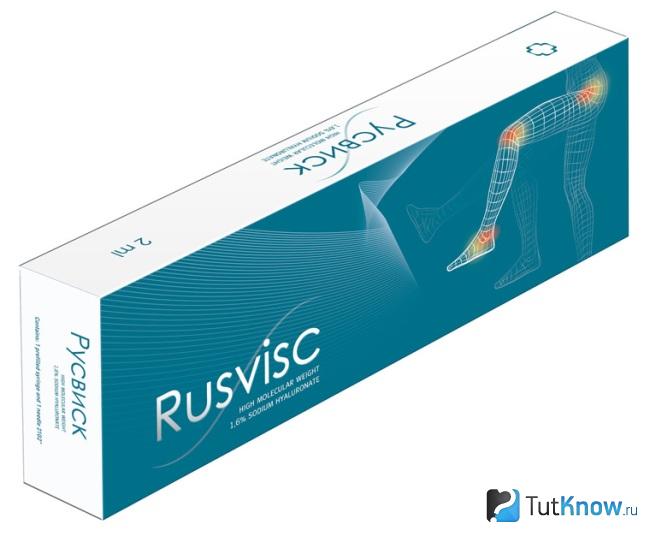
They are needed to restore damaged cartilage, give connective tissue elasticity and trigger the natural synthesis of hyaluronic acid. With their help, joint mobility and shock absorption are improved and pain is eliminated. Such drugs remain in the joint cavity for more than 3 months, acting during this time every day.
Of all the hyaluronic acid solutions available on the market for joint injections, the following deserve special attention:
- RusVik. This is a saline solution based on non-animal hyaluronic acid, supplied in a sterile disposable syringe and designed specifically for injection into the joint. It improves mobility, eliminates pain and relieves inflammation, and is used for local therapy of osteoarthritis. Its combination with anticoagulants is not allowed. Treatment is not carried out during pregnancy and lactation, in the presence of a large amount of effusion, in the case of dermatological diseases manifested at the injection site. After the injection, slight pain and redness may be observed, and in rare cases, joint mobility is limited. Before use, the syringe must be removed from the refrigerator 20 minutes. The course consists of 5 procedures with a break of a week.
- Suplazin. An injection solution used to replace synovial fluid after arthrocentesis. It is sold in sterile disposable syringes. The composition includes two components - phosphate buffer and sodium salt of hyaluronic acid. The drug is not used in case of hypersensitivity to these substances. It must be warmed in your hands before use. Up to 2 ml of medication can be injected at a time; injections for joint pain should be done every day for 3 weeks. In case of chronic rheumatic diseases, this period can be increased to 1.5 months. After administration of the composition, redness of this area, a slight increase in body temperature and the appearance of painful sensations are possible.
- Hyalux. It is produced in the form of a viscous, odorless liquid, which is a substitute for synovial fluid. It is administered for osteoarthritis of the hip, knee, shoulder, and ankle joints. This drug is excluded from therapy in case of intolerance to sodium hyaluronate. The solution is poured into syringes intended for single use. One course requires 3 injections every week, the approximate dosage is 2 mg. In rare cases, after administration of the medicine, swelling in the joint and slight pain are observed, to eliminate which ice must be applied to this area.
- Fermatron. This is another effective synovial fluid prosthesis, with the help of which homeostasis is restored in cartilage, pain is eliminated, and the synthesis of hyaluronic acid is stimulated. One syringe contains 2 ml of a solution based on pure sodium hyaluronate. It is indicated for the treatment of osteoarthritis at any stage. For this purpose, 5 injections are given at intervals of 7 days. The procedure will have to be postponed if there is inflammation, itching and redness at the injection site. After this, passing pain and swelling may occur.
- Ostenil. In addition to non-animal hyaluronic acid, this solution contains dihydrogen phosphate, monohydrogen phosphate and sodium chloride. Its use is indicated for joint pain, limited mobility and degenerative changes. It is administered once; with the doctor’s approval, the number of injections can be increased to three with a break of two weeks. Ostenil is not relevant for the treatment of children, pregnant and lactating women. After using the solution, swelling and redness of the skin may bother you.
- Synocrom. It is a highly purified, sterile preparation based on hyaluronic acid of non-animal origin. It is prescribed for the treatment of osteoarthritis of the shoulder, hip and other joints. The solution has filtering, shock-absorbing and restoring properties. To get a good effect, you need to make 5 injections with an interval of 7 days. In the initial stages, one injection may be sufficient.
Review of solutions for injections in the form of chondroprotectors
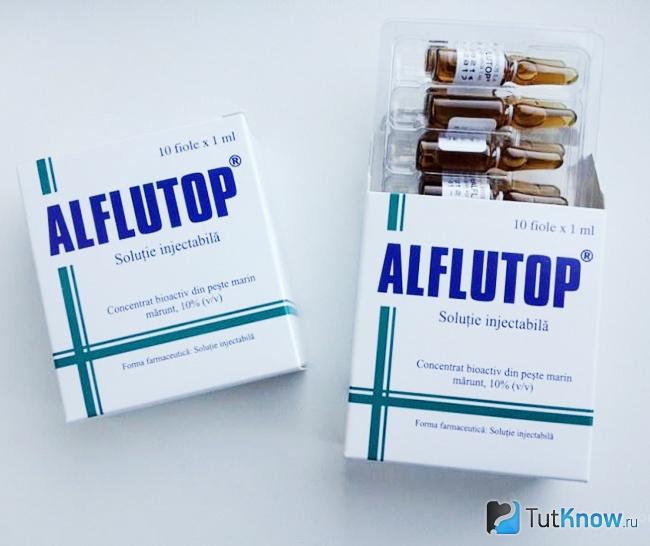
Such drugs are effective for degenerative-dystrophic changes in the hip, ankle, shoulder and other joints. They help stop the process of their destruction, stimulate metabolic processes, accelerate recovery from injuries and promote the production of your own collagen. Each of these medications can be used at all stages of the disease, but outside the exacerbation phase.
We reviewed the most effective drugs:
- Alflutop. This is a natural medicine made from sea fish bone extract, chondroitin sulfate, rosemary essential oil and a number of other active ingredients. It is characterized by a strong analgesic and anti-inflammatory effect. Its use is especially relevant for periarthritis, osteoarthrosis, and osteochondrosis. The solution is also useful during the recovery period after joint surgery. One course requires up to 20 injections, between which there must be a break of 3 days. A single dose is about 1 mg. Most often, this drug is used to treat knee joint injections.
- Chondrolone. It is available in powder form for preparing a solution. There are 3 types of packaging available for sale - 5, 10 and 20 1 ml ampoules. The active ingredient here is chondroitin sulfate sodium salts of animal origin. The drug is useful in complex therapy of patients with primary arthrosis. The contents of one ampoule must be dissolved in 1 ml of water for injection. 100 mg is administered every other day, after the fourth injection this amount is doubled. The course consists of 20 procedures, repeated after six months.
- Mucosat. This medicine for injection into joints is intended to relieve inflammation and stimulate the regeneration of cartilage tissue. Among the excipients, there is specially prepared water and benzyl alcohol, and the main one is sodium chondroitin sulfate. It is prescribed for osteoporosis, osteoarthrosis, osteochondrosis, and for recovery after bone fractures. Treatment is not carried out if there is a tendency to bleeding and thrombophlebitis. A single dosage is 100 mg, this amount is administered every other day. In one course, you need to make at least 25 injections with a break of 24 hours. As a result of such therapy, various dermatological diseases may appear; in rare cases, nausea may occur.
- Target-T. The drug belongs to the group of homeopathic medicines, its action is aimed at relieving pain, suppressing inflammation and restoring tissue. It has proven itself effectively in the treatment of polyarthrosis, tendinopathy, osteochondrosis, and rheumatoid polyarthritis. It can be used by adults and children over 6 years of age. In advanced conditions, 1-2 ampoules are prescribed once a day, and in the recovery stage, 1 piece is enough. twice a week. The solution is well tolerated by patients; allergic reactions occur only in rare cases.
Important! For greater effectiveness, injections for the treatment of joints with chondroprotectors are made after completing a course of corticosteroids.
Carbon dioxide injections for joints
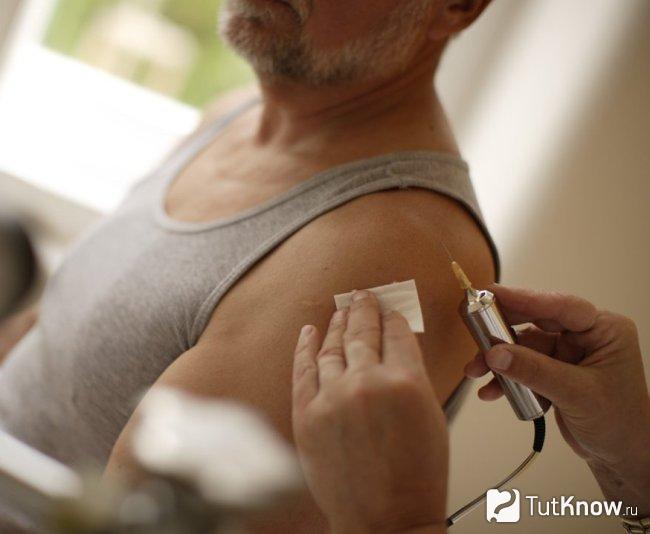
Gas injections are the basis of carboxytherapy and are intended to relieve pain from rheumatism, gout, infectious and other forms of arthritis, various types of arthrosis. Unlike conventional injections, here the “drug” is administered using a special device or a medication gun with a sterile needle at the tip.
The effectiveness of using carbon dioxide lies in the fact that after saturating the joint cavity with it, the body experiences a lack of oxygen. As a result of this, blood naturally begins to flow to this area, which enhances metabolic processes and accelerates the regeneration of cartilage tissue. After such a procedure there are almost never any side effects, since the “drug” is easily tolerated by all patients.
It is very important that gas injections can be given to almost everyone, the only exceptions being pregnant women and people with acute diseases of the cardiovascular system. To do this, the patient is seated on the couch, the injection site is disinfected, the gun reservoir is filled with the desired substance, a sterile needle is put on it and micro-injections are made. To improve your well-being, 5-7 sessions are needed. The results obtained last for a year or more.
Technique for performing intra-articular injections
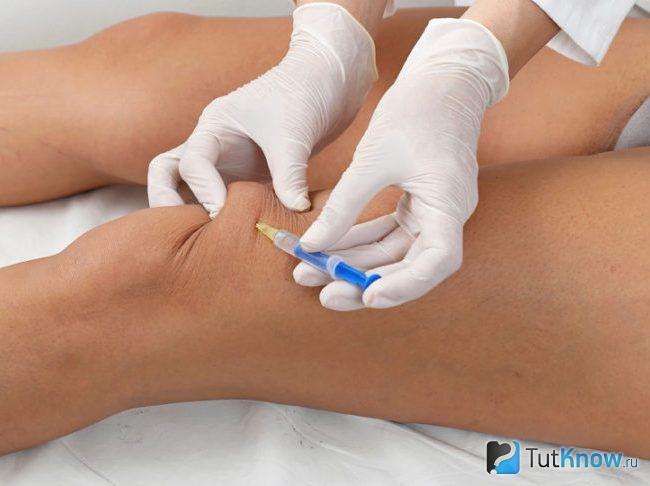
The doctor's biggest problem is getting into the joint space accurately. For this purpose, control of the procedure using ultrasound is becoming increasingly popular. Before injecting into the joint, the doctor must make sure that there is no effusion in the bursa; if present, it is recommended to remove it by drainage. After this, in case of increased pain, superficial anesthesia with cream is applied.
The correct joint injection technique consists of the following steps:
- The skin is treated with a disinfectant composition.
- A sterile needle is inserted into a disposable syringe.
- The doctor collects the required amount of medicinal solution.
- A puncture is carefully made in the problem area and the needle is gradually immersed to the maximum possible depth
- The contents of the syringe are injected into the joint space.
- The patient is given a sterile bandage and asked to make several rotational movements with the affected joint.
After the procedure is completed, it is recommended to avoid stress, alcoholic beverages and strong physical activity for several weeks.
If there is a large amount of effusion in the joint cavity, it must first be removed, and the cleaned space must be sanitized with an antiseptic. Since this procedure can be painful, you may need an injection of an anesthetic drug, but in most cases this is not necessary.
Injections should be included in complex therapy along with physiotherapy, medication, external treatment and exercise therapy. They are not done in the acute stage, when there is severe, unbearable pain, since the situation can then worsen.
